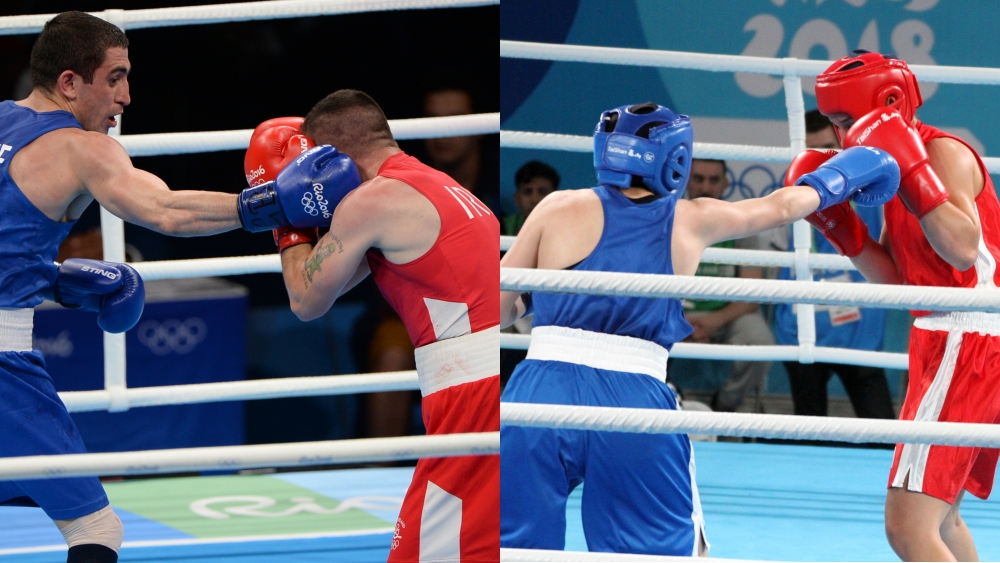Feints are one of the tiny details in boxing that separates world-class fighters from everyone else. Observe any top boxer like Manny Pacquiao, Canelo Alvarez, or Errol Spence Jr., and you’ll notice they often throw more feints than actual punches.
Feints are everything in boxing, yet beginners often don’t understand how such a subtle technique can make a significant difference in a fight. Lower-level boxers often don’t understand that quality opponents will be able to read their punches regardless of how much they try not to telegraph them. You’ll eat many counters if your opponent can predict your next move accurately. One of your top priorities inside the ring should always be to keep your opponent confused and guessing what you’ll do. Fail to do that, and well-trained opponents will easily evade your punches while landing hard counters on you.
Feinting helps you keep opponents guessing, which inevitably opens them up for attacks. For instance, let’s say you feint a jab, and your opponent bites. This shows you how they plan to counter your jab, and you can freeze them up by throwing multiple feints at them. Eventually, they stop reacting to your feints since they don’t expect you to actually throw the punch. That’s when you fire off your stiffest jab right on their nose.
Understanding How Feints Are Used In Boxing
Feinting is a lot more than simply flicking your glove at an opponent. A competent fighter won’t bite on those since they don’t use the same movements you use when punching. A feint is a deceptive movement or punch during a fight. It is a movement meant to make your opponent think you’re about to do one thing while you do something completely different.
The more the mechanics of your feints look like the same mechanics you use when throwing, the more likely your opponents will bite on them.
Common examples of the types of feints used in boxing include:
- Pretending to throw a punch to the body but going for the head instead
- Pretending to throw a punch but not throwing it
- Pretending to move in one direction while going in another direction
Feinting is not optional at the highest levels of boxing. You’ll get eaten by the boxers at the top of the food chain if you don’t mix up your offense with feints or react to every one of your opponent’s feints.
Feinting isn’t unique to boxing. It’s a part of most sports and human nature. Basketball players use pump fakes to get their opponents to make a defensive error, and mixed martial artists change levels to fool opponents into thinking they’re shooting for takedowns while they throw overhand punches.
Deception is one of the most effective survival tools humans have at our disposal, and it’s an integral part of combat and warfare. Boxing is organized war between two consenting individuals, so use all the weapons you have.
“All warfare is based on deception. Hence, when we are able to attack, we must seem unable; when using our forces, we must appear inactive; when we are near, we must make the enemy believe we are far away; when far away, we must make him believe we are near.” – Sun Tzu
That’s the goal of using deceptive movements like feints. You want your opponent to think you are vulnerable to their attacks when you aren’t. When you feint a jab, you want your opponents to slip toward your power hand.
That’s the golden rule of feinting. Do something different than what your opponent expects. The goal of a feint is to fool your opponent into thinking you’re about to do something, but there are no tricks that work when the other party knows what to expect. You can’t throw the same feints all day and expect your opponent to keep biting. You must mix feints with punches and throw many different types of feints to keep opponents guessing.
You don’t even need actually to perform a feint to feint an opponent. Boxers also deceive their opponents by mixing up combinations, and the speed punches are thrown. For example, you might throw a jab-jab-cross combo a couple of times, then fire off a jab-jab-lead hook combo. Your opponent expects you to finish your combo with a cross, and you hit them with a lead hook. That’s a feint!
The Difference Between Good Feints And Bad Ones
The difference between a good and a lousy feint is how real it looks. As we mentioned earlier, simply flicking your hand won’t cut it against high-level opponents. At best, you might get a smirk from them as they find your feints almost insulting.
The fighters with the most effective feints tend to be boxers like Floyd Mayweather, who have extremely fast, accurate punches that are never telegraphed. A simple twitch of his gloves is enough to get most boxers to jump because they know they won’t have any time to escape an incoming punch once his arm starts moving.
However, boxers who don’t command the same respect, particularly those who telegraph their punches or have slow hands, don’t enjoy that luxury. For example, a fighter who telegraphs their punches won’t have the most effective feints since opponents know they can wait for them to start throwing punches before reacting and still get out of the way.
Perfect your technique and do everything you can to improve your speed if you want your feints to be effective. You want your opponents to feel like they have to react to the slightest movement of your hands to get away from your punches.
Ineffective feints can leave you vulnerable inside the ring while not getting the desired reaction from opponents. Your opponent’s skill level impacts the effectiveness of your feints since more experienced boxers are better at reading opponents, making them less vulnerable to feints, especially terrible ones.
Being able to read opponents also makes your feints more effective. You want to feint attacks you know your opponent will react to. For example, if you’re boxing someone known to be scared of right hooks, feint right hooks a lot.
It should be noted that a fighter not responding to your feints isn’t always a bad thing. In some cases, you can use it to your advantage. For example, you can fire a hard shot at them while they’re expecting a feint.
Feints are most effective when your opponents commit more than you do. The more your opponent reacts to it, the more opportunities you have to take advantage of.
Some of the most significant advantages of using feints in boxing include:
- Feints open up your opponent to your attacks
- Feints can help you defeat physically or technically superior opponents
- Feints can give you the psychological edge during your fights as it leaves your opponents confused about what to do next
Ten Feints To Add To Your Boxing Game
Now that we’ve over how feints work and their benefits, let’s take a look at some of the most effective feints boxers use:
1) Jab To The Head Followed By A Jab To The Body
Here’s one of the more advanced combinations used in boxing. It seems simple, but timing the jab to follow through with the same hand requires lots of practice before it feels natural. Still, it’s an effective technique once you get it down. The jab to the head opens up the defense in their body to your jab. If the jab lands, there’s an excellent chance a hook will as well.
2) Jab Feint Followed By A Hard Cross
Feinting a jab can lead to an opponent extending their hands toward you to parry it. That often leaves the left side of their face open to a cross.
3) Jab At The Side Of The Head Followed By A Cross
If the jab feint followed by a cross doesn’t work for you, try throwing your jab at the air on the side of their head, forcing them to move their guard towards it and leaving the other half of their face open to a cross.
4) Cross Feint Followed By A Jab
Faking a cross often leaves your opponents open to your jab. This feint works best if you’ve already cracked your opponent a few times with your jab. Feint the cross to get them to block it, then fire off a jab at the opening created.
5) Air Punch To The Side Of The Head Followed By A Hook To The Body
Here’s a crafty feint that leaves your opponent’s body exposed when done correctly. The technique involves punching the air on the side of your opponent’s head to get them to block it and following up with a hook to the body. The easiest way to execute this move is by throwing an air jab and following up with a rear hook to the body.
6) Jab Feint To The Body Followed By A Cross To The Head
Punches to the body are one of the simplest ways to open up attacks to the head and vice versa. The same applies to feints. This is a tactic you can observe boxers using at all levels. Mike Tyson, in his prime, would bombard opponents with vicious blows to the body that would force any man to drop his guard. He’d then follow up with equally vicious hooks or uppercuts to the head that typically leave opponents unconscious.
The key to using feints to the body to set up headshots is to pay attention to your opponent’s eyes when you throw your feints. If their eyes look distracted for a second while you feint or throw a punch to the body, that’s your cue to fire hard shots to the head. Also, throw your feints toward your opponent’s rear elbow since that’s more likely to get them to overreact.
7) Jab-Cross To The Body, Followed By A Lead Hook To The Head
Here’s another effective combination that involves attacking the body to open up the head. If your feints to the body aren’t working, punch their body to force them to drop their guard before going head hunting. The jab-cross is one of the easiest and safest combinations to throw at the body, so open up your opponent’s head with the combo before firing off a powerful hook at their head.
8) Jab To The Body Followed By A Cross To The Head
The 1-2 combination is one of the first boxers’ learn, and there are no rules against mixing up your targets when executing the combo. This technique is most effective after you’ve already landed a few 1-2 combos on your opponent’s body. Just when your opponent starts to expect that, fire a jab to the body and follow up with a hard cross to the face. They won’t see it coming.
9) Hook Feint To Uppercut
Here’s one feint that Canelo uses often in his recent fights. Canelo starts by feinting a hook, forcing his opponents use the high guard to protect the side of their head while exposing their front. During the hook motion, he then makes a quick switch to land a solid uppercut on his opponents. Your opponents will never see this one coming!
10) Speed Feints
You can also trick your opponent into opening themselves up to your attacks by altering the speed you throw the punches. For example, you throw lighting fast punches with little power behind them to get your opponent to commit to defending against them.
You can also lull opponents to sleep by throwing combinations at half-speed. You can capitalize on that by periodically throwing combinations at full speed. Your opponent expects a slower barrage of punches, so they might not react quickly enough when you throw them full speed.
You can also make your combinations tricker to evade by throwing some punches at half speed while others are thrown at full speed. This makes it virtually impossible for opponents to get your timing down.
You may also like:


















